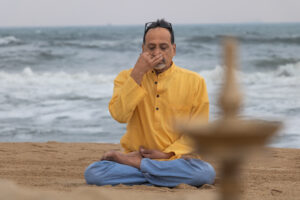Post By: Vishwanath Iyer Published on: December 30, 2016 Reading time: 6 minutes

Prāṇāyāma is an ancient Indian breath control technique that increases health, wellness and consciousness through regulation of the breath.
Every living tissue and cell requires a constant supply of energy to live. This energy is stored in the molecules of substances such as glucose, fructose, fatty acids, and amino acids which are the end products of the process of digestion of food which we eat. Energy is released by the body through a process called oxidation a process that uses oxygen. So, when there is no oxygen, the process of release of energy comes to a halt and results in the death of that tissue.
It will be observed that in any fight/flight situation, such as while taking a long or high jump, or lifting a heavy weight etc., we automatically stop the breath. Breathing is also stopped when there is a sudden shock and when there is complete absorption of the mind in something interesting. This occurs because of intensity of focus. Also, while we are resting, breathing automatically slows down, but when there is physical activity and increased need of oxygen, breathing automatically becomes faster and deeper. Therefore, there is a definite linkage between breathing and the psychosomatic functioning of the body.
Disciplining the breathing process means increased absorption of oxygen, greater efficiency of the lungs and greather psychosomatic control over our responses. This enables us to meet all the challenges that come with change. This discipline is called prāṇāyāma.
Listen to Prime Minister Narendra Modi speak on the value of prāṇāyāma.
All the above factors impact our ability to live a wholesome life, in psychosomatic equilibrium. When we are able to regulate our breath, tour breath here is visible improvement in our ability to manage change and challenges. The good news is that can be brought under control by regulation and prāṇāyāma is the science of regulating it.

Atmospheric air entering the lungs contains roughly 79% nitrogen, 20% oxygen, and traces of carbon dioxide. Out of these, only oxygen is used by the body. In exchange, the body gives up carbon dioxide and water vapour.
The wind pipe (trachea) divides into two bronchi. Each bronchus enters the lung on its side and divides itself into several branches called bronchioles. The bronchioles further divide and sub-divide themselves into fine terminal branches, and these terminate into respiratory bronchioles that hold minute air sacks called alveoli. Alveoli have a very thin lining surrounded by thin-walled capillaries that facilitate exchange of gases. Though each alveolus is a very small microscopic structure, the number of alveoli in the lungs is enormous, providing an area of almost 50 square meters for exchange of gases.
The process of exchange of gases in the alveoli to and from the blood surrounding it is called diffusion. Oxygen moves from the air to the blood and is absorbed by the haemoglobin in the blood while carbon dioxide and water vapor diffuse from the blood to the alveolar air.
Absorption of oxygen and elimination of carbon dioxide and water vapor is the essence of respiration. This process goes on continuously in us as long as we live, without requiring our attention. The body changes various elements of respiration to suit the requirements of the body and these changes are governed by the nervous system.
This is how breathing impacts health.
In normal sedentary breathing, lungs do not get completely filled or emptied in each respiratory cycle. In fact, lungs have enormous reserve capacity and some of the critical aspects that determine lung finction are:
The maximum amount of air that a person can draw out after taking a deep breath is called vital capacity and it gives information about the strength of the respiratory muscles, the ability of the lungs and size of the thoracic cage.